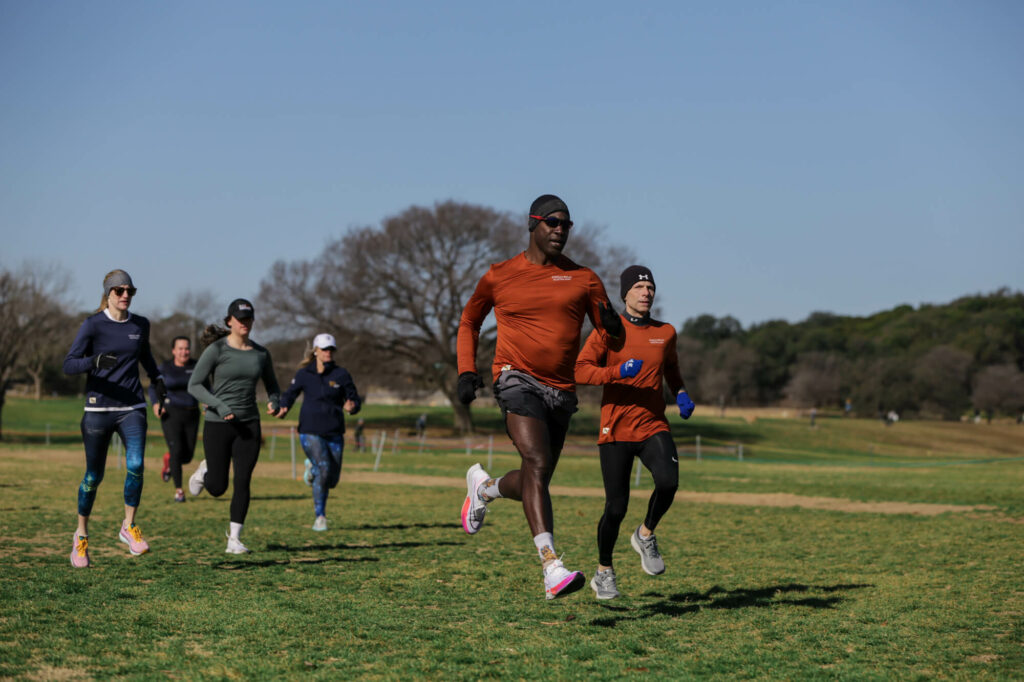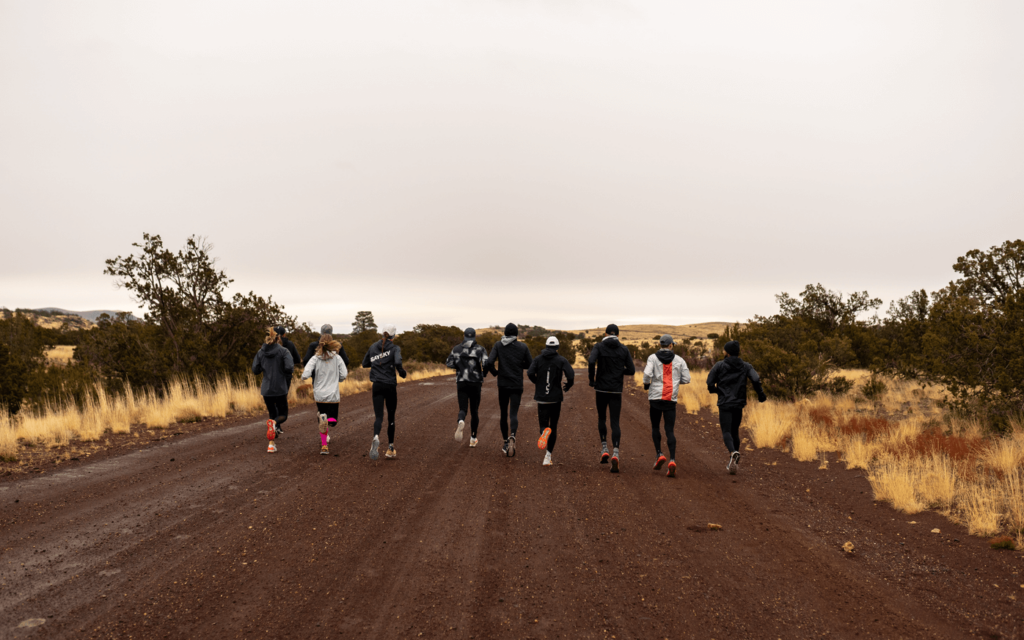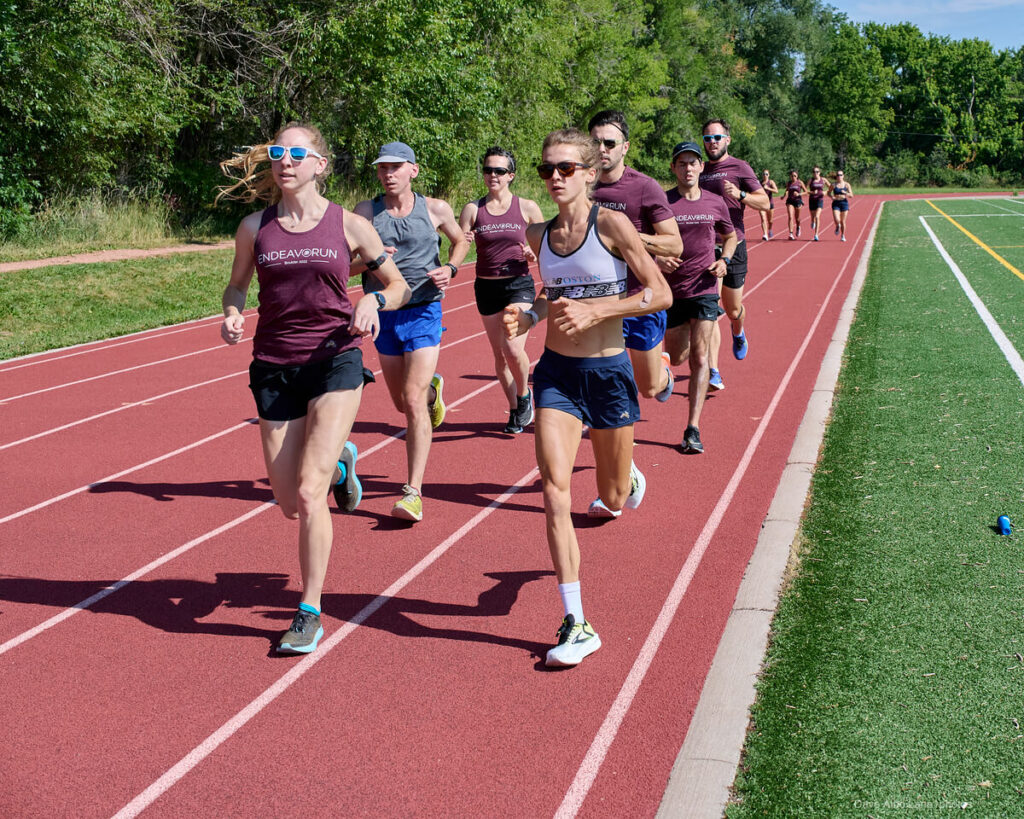It’s early 2024 and you’re months away from starting your race-specific build, even longer until race day. Are you feeling stuck in limbo, between your off-season and racing? Perhaps you’re confused about what training should look like right now. This article will explore different ways of structuring this period of pre-season training, helping you smoothly transition from the off-season to the start of your race build.

A quick refresher on periodization
An athlete’s year can usually be divided into 3 broad windows or seasons: pre-season, main/race season, and off/post-season, each lasting a matter of months.
- Pre-season: the time for ramping up training volume and intensity to prepare you for the main season.
- Main season: typically involves racing or chasing other fitness-related goals like an FKT attempt.
- Off-season: follows the main season with a period of rest and recovery, before transitioning athletes into less structured, foundation-focused training, commonly referred to as “base building”. Learn more about structuring your off-season here.
I believe this seasonal foundation is essential for an athlete to find sustained progression and longevity in sports, achieving peak performances and goals, minimizing risks for injuries and burnout, and more! However, structuring training for success is easier said than done. Let’s first explore some common mistakes athletes make during the pre-season.
Pre-season pitfalls
- Rushing straight into a race-specific build.
- Instead of a 12-week pre-season before a 12-week race build leading into a goal race, athletes commonly scrap the pre-season entirely, opting for two 12-week race-specific training cycles. Athletes falsely believe that more is better when it comes to race-specific training, and that a 24-week build will leave them fitter, faster, and better prepared for race day than 12 weeks would.
- Skipping pre-season training in favor of a longer off season.
- Similar but different to the above point about athletes’ extending periods of race-specific training, other runners delay returning to structured training until Day 1 of their X-week race build. These runners are typically highly goal-oriented and outcome focused, so without an upcoming race they feel lost and unmotivated to train. (we feel that!)
- Trying to work on everything at once
- As discussed below, the pre-season is a great time to address weaknesses and increase your running skill set, however another common trap many athletes fall into is trying to work on everything at once. A runner may identify speed, endurance, and climbing ability as weaknesses of theirs, but trying to improve all at once limits one’s ability to maximize gains in any area, as well as providing a source of mental stress and overwhelm. Instead, I suggest athletes focus on one, at most two, weaknesses at any one time.
Why pre-season
The pre-season serves as the perfect transition for runners as we go from off season to starting a race-specific training block, allowing you to gradually build volume and intensity so as to minimize injury risk and promote adaptation. Without goal races on the immediate horizon, pre-season training is ideal for building fitness and devoting time to addressing weaknesses without sacrificing race-specific training time. Think of this phase of training as building the general foundations for your running future, whereas race-specific training is more akin to renovating or redecorating a house that has already been built: the work you do now will directly benefit all performances to come.
Pre-season approaches
Understanding the importance of a proper pre-season, let’s now consider what pre-season training could look like, exploring base building, interval, and weakness-based training approaches.

Base building
The goal of base building is to increase the amount of time a runner can sustain an easy, conversational pace, a proxy measure of one’s aerobic base, and is typically achieved by progressively increasing total weekly aerobic training volume. For example, a runner increasing their weekly mileage by 10% each week. Simply by running more, you can improve your running economy and efficiency. Physiological adaptations also occur: cardiac hypertrophy (your heart gets stronger and can pump more blood with each beat), biogenesis enables an increase blood flow throughout muscles, greater mitochondrial density in the muscle cells, and increased glycogen storage and fat burning capacity allowing you to generate more energy. These physiological adaptations all translate directly to developing an athlete’s aerobic base.
However, I’m challenging you to rethink your definition of “base building” in 2024: yes, this phase does involve long, slow distance (LSD) – as does any training phase for most endurance athletes – but easy running mileage is only one part. Low impact cross training is a great way to stimulate the aerobic base at a reduced injury risk, removing the pounding and associated tissue breakdown of running moderate to high-intensity. It also adds variety and challenge to training. Examples include biking, using elliptical or stairmill machines, swimming, aqua jogging, rowing, and cross-country skiing.
To stimulate the aforementioned physiological adaptations, as well as to prevent injuries, illnesses, and burnout, the intensity of runs during a typical base building phase is kept relatively low, at an easy, conversational pace. Higher intensity, low impact activities, like bike intervals, can also be included. Additionally, I recommend athletes incorporate strides into their weekly training, anywhere from once to three times per week, after shorter easy runs. These brief, 15-30 second intervals of faster running help increase or maintain top-end speed reserves, without compromising athletes’ aerobic adaptations or recovery from training. Strides also help improve running form and technique, resulting in further economy and efficiency gains.
Example training week:
| Mon | Tue | Wed | Thu | Fri | Sat | Sun |
| Day off | Easy-mod run + 4x 20s strides | Easy run/ cross train | Medium long run | Easy run/ cross train/ day off | Fast-finish long run | Easy recovery run |
Who is this good for?
This base-building approach to the pre-season is best suited to newer runners, as well as those looking to return to the longer distances after a chunk of time away.
Who is this not good for?
For athletes with a few years of training and racing experience, especially those coming off late-season races, I recommend a more nuanced pre-season plan. The nature of trail racing requires you to have big aerobic bases: by proxy, it is highly unlikely your limiting factor is your base.

Interval training
If now is not the time for base building, what are you supposed to do instead? Fortunately, there are equally successful, alternate pre-season approaches.
A general coaching principle many in the trail and ultra world follow is that the further out an athlete is from race day, the less race-specific their training should be; this “least race-specific” training typically occurs during the pre-season. For example, a track sprinter may incorporate a weekly “distance” run of 1 mile into their pre-season training, whereas an ultrarunner may complete repeated short VO2max intervals at this time. As the racing season approaches, the sprinter may not run longer than 400m at a time, while the ultrarunner focuses on accumulating time on feet at a sustained endurance effort.
Think back to a recent trail or ultra race, or look ahead to a future one, and you’ll see that long, easy miles logged at a conversational pace, similar to some of the previously described base building training, are actually highly race-specific for most trail and ultra runners (we are volume athletes). The non-specific, interval training, approach to pre-season training flips that on its head, with the inclusion of shorter periods of higher-intensity running at speeds faster than race pace. Typically programmed two, at most three, times per week, higher-intensity running can be included in a variety of different ways: traditional time – or distance-based intervals, Fartleks, hill repeats, track work, strides, shorter-distance races or time trials, etc.
The benefits of higher-intensity running include biomechanical improvements that optimize athletes’ running economy and efficiency, in other words, improvements in running form, technique, and range of motion that reduce the energy cost of running. But perhaps most importantly, interval training, including all the ways of incorporating higher-intensity running listed above, stimulate significant improvements in cardiovascular fitness and aerobic capacity. Unlike during trail and ultra races, where athletes are likely sustaining around 60-70% of VO2 max, interval training requires athletes to work at higher intensities around 90% of their VO2 max or higher. In turn, this raises athletes’ VO2 max and lactate threshold, as well as their ability to buffer lactate in their blood, enabling athletes to sustain a higher percentage of their VO2 max for longer. Additionally, by raising one’s VO2 max, an athlete’s output running at 60-70% is greater as a result of this increased capacity – i.e. you can run faster at a much lower cost.
Example training week:
| Mon | Tue | Wed | Thu | Fri | Sat | Sun |
| Easy run/ cross train | Fartlek:10x 1 min fast/ 1-2 mins easy | Easy recovery run | Day off | Easy run/ cross train | Hills:5x 3 min hills/ easy jog down | Easy recovery run |
Who is this good for?
The opposite to base building: athletes with a few years of training and racing experience, especially those coming off late season races, in addition to extremely time-limited runners.
Who is this not good for?
Beginner runners and those without recent racing experience, as well as injury prone athletes, would likely benefit more from the aforementioned base building approach.
Working on weaknesses
The pre-season is an ideal time for working on weaknesses, leveling up the skills you’ll need to maximize race day success. Perhaps you come to the trails with a road running background, proficient at faster speeds on predictable, non-technical terrain. Why not spend a couple months practicing power hiking steep unhills, chasing vert over pace. Alternatively, runners who have logged years on the trails, focused on ultra distances, or come from another sport besides running, may benefit from working on turnover and leg speed on flatter, more runnable paths.
When assessing weaknesses, start by reflecting on past performances and training blocks, then look ahead to the specific demands of goal races and future events to come. Rate yourself on a 1-10 scale on these areas, then pick one or two that you scored lowest on to focus on.
- Endurance
- Speed/ leg turnover
- Climbing
- Mindset/ psychology
- Navigation (including map reading)
- Terrain management (especially on technical trails)
- Problem solving/ dealing with uncontrollables
- Fueling
- Hiking
- Night/ adverse conditions running
I recommend athletes focus only on one weakness at a time, acknowledging that as you level up year to year, you get better across the board in all areas. Note: not all these areas are applicable to every athlete, so disregard the ones that aren’t. For example, if you never plan on running an ultra, practicing running at night is unlikely to be an efficient use of your time and so on.
Who is this good for?
Everyone! Well, unless you are a GOAT like Courtney Dwalter or Killian Jornet and are virtually faultless…

Additional notes
This time of year is a great time for building running-supporting habits around strength training, nutrition, and recovery. If you were to ask me when the best time to initiate a strength training regime is pre-season would be my answer. Set yourself up for success by getting in a routine now before training demands increase. Commit to a consistent bed and wake time; dial in your pre, post, and in-workout fueling; stay hydrated throughout the day; make weekly strength training a non-negotiable; and start using those foam rollers and fancy recovery tools you have collecting dust on a regular basis!
References
Gute, D., Laughlin, M. H., & Amann, J. F. (1994). Regional changes in capillary supply in skeletal muscle of interval-sprint and low-intensity, endurance-trained rats. Microcirculation (New York, N.Y. : 1994), 1(3), 183–193. https://doi.org/10.3109/10739689409148273
Laughlin, M. H., & Roseguini, B. (2008). Mechanisms for exercise training-induced increases in skeletal muscle blood flow capacity: differences with interval sprint training versus aerobic endurance training. Journal of physiology and pharmacology : an official journal of the Polish Physiological Society, 59 Suppl 7(Suppl 7), 71–88.
Sahlin, K., Mogensen, M., Bagger, M., Fernström, M., & Pedersen, P. K. (2007). The potential for mitochondrial fat oxidation in human skeletal muscle influences whole body fat oxidation during low-intensity exercise. American journal of physiology. Endocrinology and metabolism, 292(1), E223–E230.
Turpeinen, J. P., Leppävuori, J., Heinonen, O. J., Kaila, K., Salo, J., Lilja, M., & Kesäniemi, Y. A. (2006). Muscle fiber type I influences lipid oxidation during low-intensity exercise in moderately active middle-aged men. Scandinavian journal of medicine & science in sports, 16(2), 134–140. https://doi.org/10.1111/j.1600-0838.2004.00436.x
Koral, J., Oranchuk, D. J., Herrera, R., & Millet, G. Y. (2018). Six Sessions of Sprint Interval Training Improves Running Performance in Trained Athletes. Journal of strength and conditioning research, 32(3), 617–623. https://doi.org/10.1519/JSC.0000000000002286
Schütz, U. H., Ehrhardt, M., Beer, M., Schmidt-Trucksäss, A., & Billich, C. (2019). Pre-race determinants influencing performance and finishing of a transcontinental 4486-km ultramarathon. The Journal of sports medicine and physical fitness, 59(10), 1608–1621. https://doi.org/10.23736/S0022-4707.19.09840-2
Acevedo, E. O., & Goldfarb, A. H. (1989). Increased training intensity effects on plasma lactate, ventilatory threshold, and endurance. Medicine and science in sports and exercise, 21(5), 563–568.
